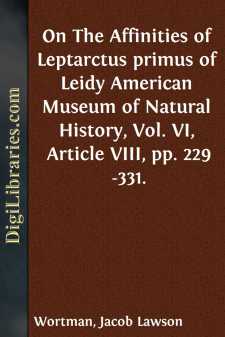Categories
- Antiques & Collectibles 13
- Architecture 36
- Art 48
- Bibles 22
- Biography & Autobiography 813
- Body, Mind & Spirit 142
- Business & Economics 28
- Children's Books 14
- Children's Fiction 11
- Computers 4
- Cooking 94
- Crafts & Hobbies 4
- Drama 346
- Education 46
- Family & Relationships 57
- Fiction 11829
- Games 19
- Gardening 17
- Health & Fitness 34
- History 1377
- House & Home 1
- Humor 147
- Juvenile Fiction 1873
- Juvenile Nonfiction 202
- Language Arts & Disciplines 88
- Law 16
- Literary Collections 686
- Literary Criticism 179
- Mathematics 13
- Medical 41
- Music 40
- Nature 179
- Non-Classifiable 1768
- Performing Arts 7
- Periodicals 1453
- Philosophy 64
- Photography 2
- Poetry 896
- Political Science 203
- Psychology 42
- Reference 154
- Religion 513
- Science 126
- Self-Help 84
- Social Science 81
- Sports & Recreation 34
- Study Aids 3
- Technology & Engineering 59
- Transportation 23
- Travel 463
- True Crime 29
On The Affinities of Leptarctus primus of Leidy American Museum of Natural History, Vol. VI, Article VIII, pp. 229-331.
Categories:
Description:
Excerpt
Up to the present time but very little has been known of the existence of the peculiarly American family Procyonidæ in any deposits older than the very latest Quaternary. Leidy has described and figured an isolated last upper tooth, from the Loup Fork deposits of Nebraska, under the name of Leptarctus primus, which has been referred to this family. The Museum Expedition of last year into this region was successful in obtaining additional material, which we provisionally refer to Leidy’s species.
Leptarctus primusLeidy.The specimen consists of the right ramus of the lower jaw, carrying the third and fourth premolars and the canine. The condyle is broken away, but the coronoid process and the angle are preserved. The specimen is from a young individual in which the last premolar had just cut the gum. The alveoli of all the other teeth are present and in a good state of preservation.
The dental formula is as follows: I., C., Pm., M.. The incisors are not preserved, but their alveoli indicate that they were much crowded, the outside one being placed almost directly in front of the canine, and the middle one pushed back considerably out of position. This series is in marked contrast with that of the Raccoon, in which the crowns of the incisors form almost a straight line across the jaw, and the middle one is crowded backwards to a very slight extent. The canine is peculiar and differs markedly from that of the Raccoon. It is rather robust, very much recurved and grooved by a deep vertical sulcus upon its antero-internal face. This sulcus is but faintly indicated in the Raccoon. The postero-external face of the crown is marked by a sharp ridge which becomes more prominent near the apex. The first premolar is not preserved, but its alveolus indicates that it was a single-rooted tooth, placed behind the canine after the intervention of a very short diastema. The second premolar is bifanged; its crown is composed of a principal cusp, to which is added behind a small though very distinct second cusp. There is in addition to these cusps a distinct basal cingulum, most prominent in the region of the heel. The third premolar, like the second, is double rooted; its crown moreover is made up of two cusps, the posterior being almost as large as the principal one. These cusps do not stand in the line of the long axis of the jaw, but are placed very obliquely to it. The heel is not very prominent, but the basal cingulum is well developed, both in front and behind. As compared with the Raccoon, the second premolar is more complex in that it has two cusps instead of one. In the third premolar the posterior cusp is much better developed, and placed more obliquely than in the corresponding tooth of Procyon; the heel is moreover not so broad.
The first molar is not preserved, but judging from the size of its roots it was decidedly the longest tooth of the series. The second molar was likewise bifanged but much smaller; it was placed close against the base of the coronoid.
The whole jaw has, relatively, a greater depth than that of the Raccoon, and is remarkably straight upon its lower border, whereas in the recent genus it is considerably curved. The condyle is not preserved, and the angle is somewhat damaged, but it was apparently not so strongly inflected as in the Raccoon. The masseteric fossa is deep and prominent, and the coronoid is high and broad. The inferior dental canal is placed higher than it is in the Raccoon, being slightly above the tooth line....


